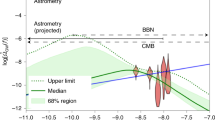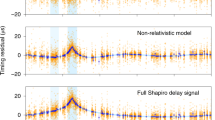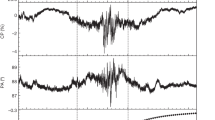Abstract
The newly discovered millisecond pulsar PSR1937 + 214 has such a high rotational rate, 642 Hz, that any significant quadrupole moment not aligned with the spin axis could lead to a large flux of gravitational radiation. Although recently reported1–3 slowdown rates suggest an energy loss corresponding to a currently unobservable level of gravitational radiation, existing evidence may not completely rule out all possibilities for production of detectable gravitational waves. For example, continuing accretion might provide additional energy for gravitational radiation; and it may not be impossible that the pulsar might be closer to the Earth than indicated by the dispersion measure if there was large local dispersion. Overall, the parameters of this pulsar seem so exceptional that a direct search for gravitational radiation with existing equipment seemed worth making. We describe here such a search that has set an upper limit to gravitational wave amplitude at twice the pulsar rotation frequency, the observed output from a gravitational wave detector corresponding at this frequency to an amplitude of (0.8+1.5−0.8) × 10−20.
This is a preview of subscription content, access via your institution
Access options
Subscribe to this journal
Receive 51 print issues and online access
$199.00 per year
only $3.90 per issue
Buy this article
- Purchase on Springer Link
- Instant access to full article PDF
Prices may be subject to local taxes which are calculated during checkout
Similar content being viewed by others
References
Backer, D. C., Kulkarni, S. R., Heiles, C., Davies, M. M. & Goss, W. M. Nature 300, 615–618 (1982).
Ashworth, M., Lyne, A. G. & Smith, F. G. Nature 301, 313–314 (1983).
Backer, D. C., Kulkarni, S. R. & Taylor, J. H. Nature 301, 314–315 (1983).
Drever, R. W. P., Hough, J., Bland, R. & Lessnoff, G. W. Nature 246, 340–344 (1973).
Hough, J., Pugh, J. R., Bland, R. & Drever, R. W. P. Nature 254, 498–501 (1975).
Horowitz, P. Rev. scient. Instrum. 40, 369–370 (1969).
Author information
Authors and Affiliations
Rights and permissions
About this article
Cite this article
Hough, J., Drever, R., Ward, H. et al. Direct observational upper limit to gravitational radiation from millisecond pulsar PSR1937 + 214. Nature 303, 216–217 (1983). https://doi.org/10.1038/303216a0
Received:
Accepted:
Issue Date:
DOI: https://doi.org/10.1038/303216a0
This article is cited by
-
Search for monochromatic sources with the GEOGRAV gravitational-wave antenna
Il Nuovo Cimento C (1991)
-
Millisecond pulsars
Journal of Astrophysics and Astronomy (1984)
Comments
By submitting a comment you agree to abide by our Terms and Community Guidelines. If you find something abusive or that does not comply with our terms or guidelines please flag it as inappropriate.



